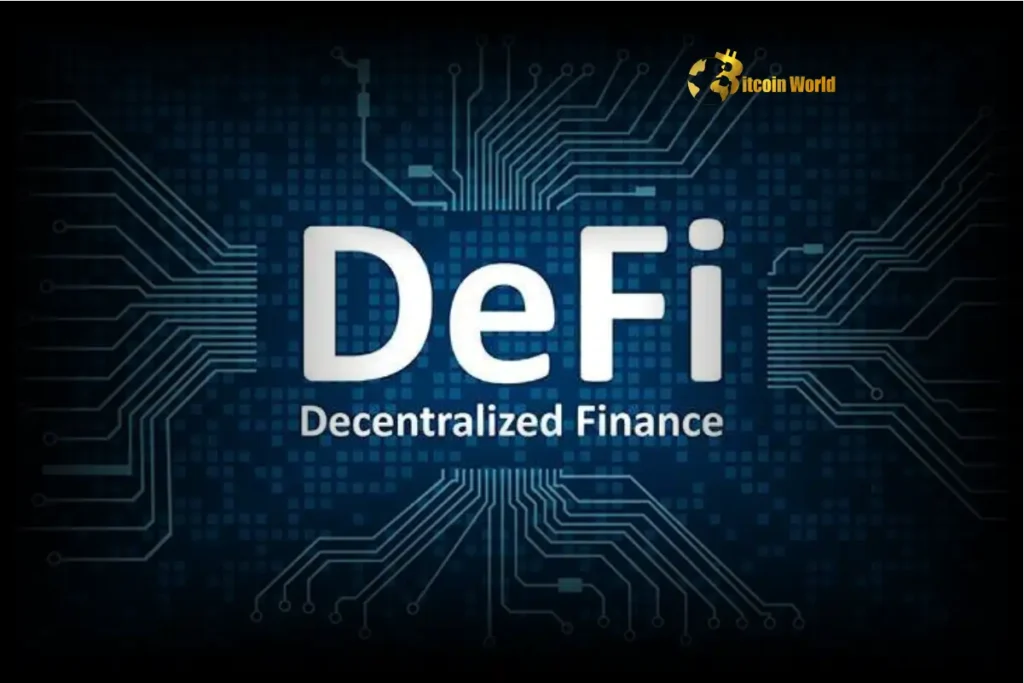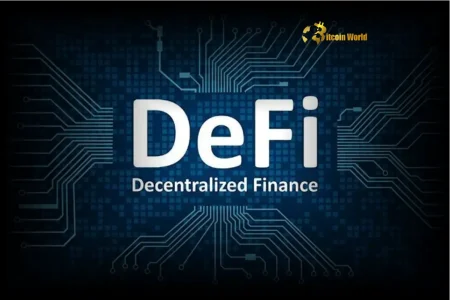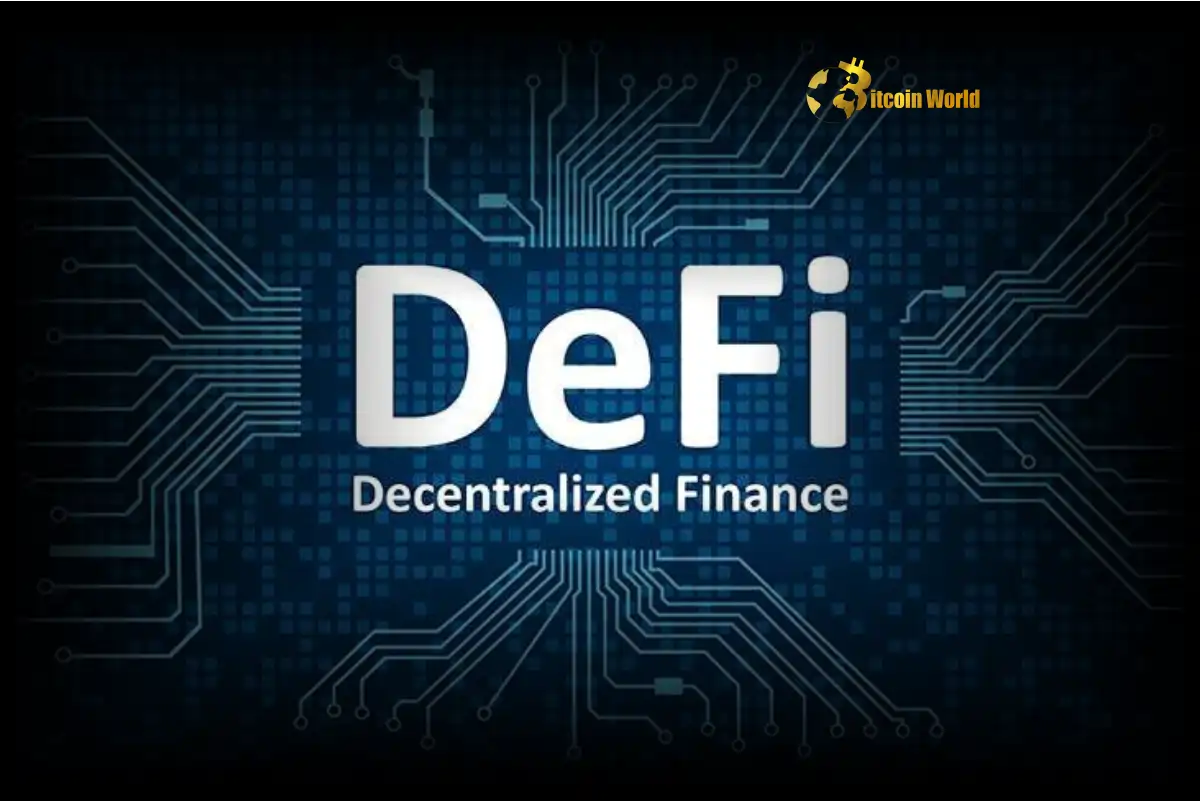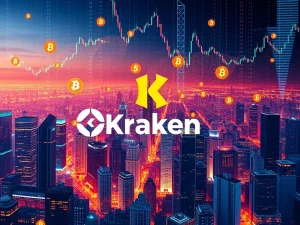Decentralized Finance: The Explosive Future of Finance

BitcoinWorld
Decentralized Finance: The Explosive Future of Finance
Are you ready to explore a financial revolution? Decentralized Finance, or DeFi, is rapidly reshaping how we think about money, banking, and investments. It’s a movement built on blockchain technology, aiming to create a financial system that is open, transparent, and accessible to everyone, everywhere, without relying on traditional intermediaries like banks.
What is Decentralized Finance and Why is it Gaining Traction?
At its core, Decentralized Finance is about taking traditional financial services – like lending, borrowing, trading, and insurance – and rebuilding them on decentralized blockchain networks, primarily Ethereum, but increasingly on others too. Imagine a world where you can get a loan, earn interest on your savings, or trade assets directly with another person through secure, self-executing contracts called smart contracts, all without a bank in the middle. That’s the promise of DeFi.
The traction comes from several key benefits:
Accessibility: Anyone with an internet connection and a crypto wallet can participate, regardless of their location or economic status.
Transparency: Transactions are recorded on a public ledger (the blockchain), making them verifiable and transparent (though not always tied to real-world identities).
Efficiency: Automated smart contracts can process transactions much faster and cheaper than traditional manual processes.
Innovation: The open nature of DeFi allows developers to build and combine protocols in novel ways, leading to rapid innovation and new financial products.
This shift represents a significant paradigm change, moving power away from centralized institutions and towards individuals.
Exploring Key DeFi Trends Shaping the Future of DeFi
The landscape of Decentralized Finance is constantly evolving, driven by relentless innovation. Staying informed about key DeFi Trends is crucial to understanding where this technology is headed and its potential impact on the Future of DeFi.
Some of the most significant trends include:
Layer 2 Scaling Solutions
High transaction costs (gas fees) and network congestion have been major hurdles, especially on Ethereum. Layer 2 solutions like rollups (Optimistic and zk-Rollups) process transactions off the main blockchain, significantly reducing costs and increasing speed. This is vital for making DeFi accessible to a wider audience.
Cross-Chain Interoperability
Originally, DeFi was largely confined to single blockchains. Now, bridges and protocols are being developed to allow assets and data to move seamlessly between different blockchains (like Ethereum, Binance Smart Chain, Solana, Polkadot). This expands the potential user base and liquidity for DeFi Protocols.
Real-World Assets (RWAs) Integration
Bridging the gap between traditional finance and DeFi by bringing real-world assets like real estate, stocks, and commodities onto the blockchain. Tokenizing RWAs can unlock massive amounts of liquidity and create new investment opportunities within DeFi.
Institutional Adoption
While DeFi started as a retail phenomenon, institutions are increasingly exploring and entering the space. This includes investment firms, banks, and corporations looking for new yield opportunities, trading strategies, and ways to use blockchain technology for their operations. This trend could bring significant capital and legitimacy to Decentralized Finance.
Focus on Regulation and Compliance
As DeFi grows, regulators worldwide are paying closer attention. Future trends will heavily involve developing solutions and frameworks that allow DeFi activities to comply with existing and new financial regulations, balancing decentralization with necessary oversight.
Diving into Prominent DeFi Protocols and How They Work
The functionality of Decentralized Finance is delivered through various types of DeFi Protocols, each serving a specific purpose. Understanding these categories helps illustrate the breadth of what DeFi offers.
Here are some major categories of DeFi protocols:
Decentralized Exchanges (DEXs): Platforms like Uniswap or SushiSwap allow users to trade cryptocurrencies directly with each other using automated market makers (AMMs) or order books, without a central authority holding funds.
Lending and Borrowing Protocols: Protocols such as Aave or Compound allow users to lend out their crypto assets to earn interest or borrow assets by providing collateral. Rates are determined algorithmically based on supply and demand.
Yield Farming and Liquidity Mining: Users deposit crypto into liquidity pools on DEXs or lending protocols to facilitate trading or lending, and in return, they earn fees and/or new tokens as rewards. This is a popular way to generate passive income in Crypto DeFi.
Derivatives Protocols: Platforms for trading tokenized derivatives, allowing users to speculate on the price movements of various assets (crypto or real-world) using leverage.
Insurance Protocols: Offer decentralized insurance against risks like smart contract bugs or stablecoin de-pegging, providing a safety net for DeFi participants.
These protocols often interact with each other, creating complex ecosystems where users can combine different services, a concept known as ‘money legos’.
The Role of Crypto DeFi in Financial Innovation
Crypto DeFi isn’t just replicating traditional finance; it’s inventing entirely new ways to manage and interact with assets. It allows for permissionless innovation, meaning anyone can build on top of existing protocols or create new ones without needing approval from a central body. This fosters rapid experimentation and the development of financial products previously unimaginable in the traditional system.
For example, flash loans allow users to borrow large sums of money without collateral, provided the loan is repaid within the same transaction. While risky, this enables complex arbitrage strategies and highlights the unique capabilities unlocked by smart contracts. DeFi is pushing the boundaries of what’s possible in finance, offering new opportunities for earning yield, accessing capital, and managing risk.
Navigating the Challenges and Risks in Decentralized Finance
While the promise of Decentralized Finance is immense, it’s not without significant challenges and risks. It’s crucial for anyone participating in DeFi to be aware of these pitfalls.
Key challenges include:
Smart Contract Risk: Protocols rely on code. Bugs or vulnerabilities in smart contracts can lead to loss of funds, as highlighted by past hacks and exploits.
Regulatory Uncertainty: The lack of clear regulations in many jurisdictions creates legal and operational risks for both users and developers.
Market Volatility: The underlying crypto assets used in DeFi are often highly volatile, which can impact the value of collateral, yields, and overall investment.
User Experience: DeFi interfaces can be complex and intimidating for newcomers compared to traditional banking apps.
Gas Fees: While Layer 2 solutions are helping, high transaction fees on base layers like Ethereum can still make small transactions uneconomical.
Actionable Insight: Always do your own research (DYOR) before interacting with any DeFi protocol. Understand how it works, assess the risks, and only commit funds you can afford to lose. The decentralized nature means there’s often no central authority to recover funds if something goes wrong.
What’s Next? The Explosive Future of DeFi
Looking ahead, the Future of DeFi appears set for continued growth and integration. The ‘Explosive Future‘ isn’t just about more protocols; it’s about greater adoption, improved user experience, and increasing connectivity with the broader digital economy.
We can anticipate more sophisticated protocols, better risk management tools, and wider integration with Web3 applications, gaming, and the metaverse. As regulatory clarity emerges and technology improves (especially with scaling solutions), DeFi has the potential to move from a niche crypto application to a fundamental layer of the global financial system.
Summary: Decentralized Finance is Reshaping Finance
In conclusion, Decentralized Finance is a transformative force in the financial world. By leveraging blockchain technology, it offers a vision of finance that is more open, accessible, and efficient than ever before. While challenges like security and regulation remain, the ongoing innovation in DeFi Trends and the development of robust DeFi Protocols point towards an exciting and potentially Explosive Future. Understanding Crypto DeFi is no longer just for crypto enthusiasts; it’s becoming essential for anyone interested in the evolution of finance.
To learn more about the latest crypto market trends, explore our article on key developments shaping Decentralized Finance institutional adoption.
This post Decentralized Finance: The Explosive Future of Finance first appeared on BitcoinWorld and is written by Editorial Team












